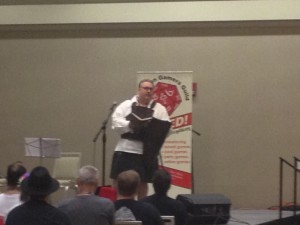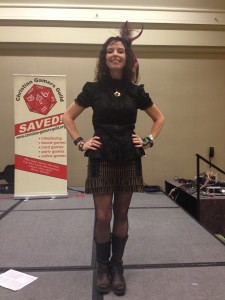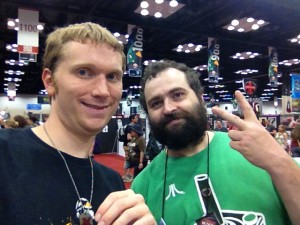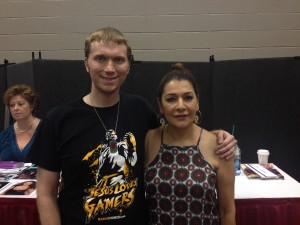 Today, September 8, 2016, marks the 50th anniversary of the Star Trek franchise. It’s no secret that I’m a Trekker. Heck, almost every version of my author bio mentions that my love of speculative fiction—and by extension, writing—came from watching late-night reruns of the original Star Trek series with my Dad. It didn’t stop there, though. I ate up everything Trek. I watched all the spin-offs. I was obsessed with the movies. I had/have toys, magazines, and books. Star Trek defined science fiction for me for a long time. It was my first and possibly most important fandom.
Today, September 8, 2016, marks the 50th anniversary of the Star Trek franchise. It’s no secret that I’m a Trekker. Heck, almost every version of my author bio mentions that my love of speculative fiction—and by extension, writing—came from watching late-night reruns of the original Star Trek series with my Dad. It didn’t stop there, though. I ate up everything Trek. I watched all the spin-offs. I was obsessed with the movies. I had/have toys, magazines, and books. Star Trek defined science fiction for me for a long time. It was my first and possibly most important fandom.
What makes this franchise appealing to me are its cerebral stories, amazing characters, and positive outlook. Gene Roddenberry, the creator of Star Trek, intended the show to not simply be escapist entertainment but stories that tackled current issues head-on and spurred viewers to think deeply about them. This, in my opinion, is not only a mark of good science fiction but also a mark of good storytelling and art.
So, in honor of this golden anniversary, I’m presenting my top ten favorite episodes of all the Trek series (I’m excluding Star Trek: The Animated Series since all but one episode isn’t considered canonical). It wasn’t easy narrowing this down or ranking the episodes. Some series have too many good ones to pick from.
Regardless, it’s time “to boldly go where no man has gone before”!
- In a Mirror, Darkly (Star Trek: Enterprise)
Enterprise, despite a solid cast and premise—a prequel series showing the early days of Starfleet and the formation of the United Federation of Planets—took several seasons to figure itself out. At a time when superior shows like Firefly were getting cancelled after only 14 episodes, it’s astonishing this show was given that long to find its space legs (it was probably because UPN was desperate). Sadly, it was cancelled prematurely.
Regardless, while Enterprise never quite reached the heights of Deep Space Nine or The Next Generation, it did have some good episodes. The best was this two-parter from near the end of its fourth and final season. It makes callbacks to several Original Series episodes, most notably “Mirror, Mirror” and “The Tholian Web,” and ties up some loose ends from them. It takes place in the Mirror Universe, where all the good guys are evil (hence “bearded Spock” in the original episode), so we get to see the entire cast ham it up as their evil counterparts. We see the formation of the Terran Empire. We see what became of the U.S.S. Defiant. We even see a Gorn! The proverbial cherry on top, though, was the new title sequence created specifically for this two-parter which showed the alternate, warlike history of the Mirror Universe. That hasn’t been done in any other episode of any Trek series, making it unique.
- Scorpion (Star Trek: Voyager)
Voyager started with such promise: a Federation starship stranded in a distant, unexplored region of the galaxy while integrating a group of Maquis (i.e. terrorist) operatives into their crew. Sadly, it never fully utilized or explored this set-up. Plus, the characters and plots didn’t always work or relied on gimmicks.
But then came this epic two-parter, which served as the third season finale and the fourth season premiere. It featured the first post-Star Trek: First Contact appearance of the terrifying Borg. This cybernetic horde was previously established as originating from the Delta Quadrant, the region of the galaxy the U.S.S. Voyager had been stranded in, so this was something bound to happen. However, the Borg had now encountered a race from another dimension so powerful, it could kick them around like a schoolyard bully. Dubbed Species 8472, they sought to destroy all life in our universe. Captain Janeway, desperate to get Voyager home, decides to “appeal to the devil” and offers to help the Borg fight Species 8472 in exchange for safe passage through the cyber-horde’s space. This causes conflict in the crew, showing how dysfunctional they could’ve been if written properly, but ultimately culminates in a harrowing war. The episode also marked the first appearance of arguably the series’ best character: the former Borg drone Seven of Nine.
If I had any complaints, it’s that the Borg started showing far too often after this and Species 8472 was all but de-fanged later.
- Trials and Tribble-ations (Star Trek: Deep Space Nine)
Twenty years ago for the franchise’s 30th anniversary, both Deep Space Nine and Voyager celebrated with special episodes. However, DS9’s is the best. In a much lighter episode than was typical of the series (you’ll see why farther down the list), Captain Sisko and crew are transported back in time to the TOS era—specifically to the fan-favorite episode “The Trouble with Tribbles”—by a Klingon spy who was exposed by Captain Kirk in that episode. What follows is a borderline meta-story with several of the DS9 characters “geeking out” as they try to thwart the Klingon villain’s plot without interfering with the timeline. There are some good-natured jokes poked at TOS, but it’s mostly a tribute.
The best scene, hands down, is when the DS9 character walk into a bar filled with TOS Klingons, who lack forehead ridges, and bombard Worf with questions trying to figure out what happened (this had been a longstanding point of confusion/contention among fans). Worf simply replied, “We don’t talk about it with outsiders.” (Enterprise would later explain it, for better or worse).
The episode was created using green screen technology that seamlessly added the DS9 actors into footage from the original episode. Classic sets were re-created. The episode is also notable for presenting the original Enterprise and the space station with CGI, setting the precedent for the remastered version of TOS that would come later.
- Relics (Star Trek: The Next Generation)
Noticing a pattern with some of my entries on this list? If not, it’s that I like episodes that harken back to TOS (which is my favorite of the Trek series). While TNG featured appearances by three TOS characters, this is arguably the best. James Doohan reprises his role as Scotty, the engineer on the first two Enterprises whose repairs could defy physics. Here he is discovered by the Enterprise-D being held in a transporter buffer to survive his ship’s crash landing. He predictably clashes with Geordi la Forge, the more seriously-minded engineer of the new Enterprise, but they eventually team-up to save the ship from being trapped in a Dyson sphere.
The episode is definitely carried by Doohan, who plays Scotty as an old-timer past his prime living in an era he doesn’t understand and which doesn’t understand him. There’s a great moment where he goes to the holodeck and has it recreate the bridge of his Enterprise so he can reminisce (when the computer which Enterprise he wants, Scotty replies, “NCC one seven oh one. No bloody A, B, C, or D.”) He’s joined by Captain Picard, who shares a drink with him. It’s one of several great moments.
- Amok Time (Star Trek: The Original Series)
This is one of the seminal episodes of TOS. People only passingly familiar with the series know about this episode. It did significant world-building regarding Vulcan culture and biology as well as explaining important parts of Spock’s background. It also features many of the common TOS tropes (like Kirk getting his shirt ripped). In this, Spock must return to home planet and take a wife before he dies from pon-farr, a time of madness when a Vulcan’s mating instincts kick into high-gear. It daringly touched on a difficult subject—sexuality—by couching it in an alien culture. It also saw the friendship between Kirk and Spock (and to a lesser extent those two and Dr. McCoy) tested to an extent not seen before and possibly never equaled since. The climax has Kirk fighting Spock to the death as part of an ancient Vulcan ritual. I won’t spoil the ending, but it’s a great one.
This was an ambitious episode that spared no expense. It has a fairly large set for the surface of Vulcan and extensive costuming. The fight choreography is some of the best in the entire series. The tension runs high as the episode progresses. Leonard Nimoy gives one of his greatest performances as Spock. It’s also noteworthy for marking the first appearance of the famous Vulcan salute and the phrase, “Live long and prosper.”
- The City on the Edge of Forever (Star Trek: The Original Series)
What?! This is only number five on my list when it’s usually regaled as the greatest episode of TOS! You can stone me later.
No Trek list is complete without it, so I had to include it. I don’t deny its greatness it’s just that there’s an episode I like a bit more. Regardless, it’s amazing, if you know of the episode’s storied production, that it turned out as great as it is. In this, Kirk and Spock travel back in time via the Guardian of Forever to prevent Dr. McCoy, who’s in a drug-induced mania, from altering the course of history. Kirk and Spock find themselves in Depression-era New York City, where they meet a woman named Edith Keeler who runs a homeless shelter. Despite the misery around her, she remains optimistic that humanity will one day reach the stars and end war. Kirk, predictably, falls in love with her. However, Spock discovers that she will die a week later. Complicating matters, he also figures out (because he’s Spock and he’s smarter than everyone) that McCoy will prevent her death, allowing her to lead an anti-war movement that keeps the United States out of WWII, allowing the Axis to win. So, Kirk faces a moral dilemma: does he save the woman he loves or save history?
This was the most expensive episode of the show’s first season, what with its location shooting and brand-new sets. But it’s the writing and acting that elevates the episode. William Shatner, known for his often hammy overacting, gives a heartbreaking, nuanced, and subdued performance. While the audience knows what’s coming, it still packs a potent punch. It’s a rare time where we see Kirk affected by one of his love interests. No wonder it’s ranked by many people who worked on the series as their favorite episode.
- Tapestry (Star Trek: The Next Generation)
I know most people rank “The Inner Light” as the best Picard episode, but I always preferred this one. For one thing, I remember watching this more often than “The Inner Light” and connecting with it more. Plus, it has Q in it. No TNG list is complete without the nigh-omnipotent imp.
Picard seemingly dies and meets Q, who allows Kirk to inhabit the body of his younger self and prevent the heart injury that eventually led to his death. What follows is equal parts It’s a Wonderful Life and A Christmas Carol. Picard not only witnesses the events of his life, which included getting into a bar fight where he was stabbed through the heart, but he also gets a chance to make changes and see how his life would’ve been different. While he saves his life, he also never becomes the captain of the Enterprise-D and instead serves as an unremarkable junior officer. It forces him to choose between surviving and being ordinary or dying after extraordinary life.
The episode offered tremendous insight into Picard’s character and backstory. We see that he wasn’t always the level-headed diplomat of a captain he is now. We see the moment that changed his life. The episode also saw great development for Q, who evolved from being a petty imp to a nuanced, three-dimensional character. The brilliance of the episode (spoiler warning) is it’s never revealed if Picard’s experiences were real, a dream, or an illusion created by Q to teach Picard a lesson. Any of those could be true.
- In the Pale Moonlight (Star Trek: Deep Space Nine)
Remember what I said about DS9 being dark? This episode illustrates that in deep shadows! While many argue it doesn’t adhere to Roddenberry’s optimistic view of humanity or his vision for Star Trek, it’s quite possibly the best episode of DS9.
By this point in the series, the Federation was at war with a race of shapeshifting aliens from the Gamma Quadrant called the Dominion. The Dominion was determined to wipe out all the “solids” in the galaxy (their natural form is a gelatinous goo, hence the slur). The Federation had managed to make an alliance with the Klingon Empire, but the war wasn’t going well. The Romulan Empire was neutral in the conflict, but the Dominion had extended overtures to them. Their choice would tip the balance of power.
The story is told in flashback as Sisko records his confession in his log. Sisko knew from his dealings with the Dominion that they would destroy the Romulans once they won the war, but he had no evidence to prove it. With a Romulan ambassador soon to visit the station, he turned to Garak, a former spy, to manufacture evidence of the Dominion’s treachery. After a long string of shady dealings, the evidence is made and presented to the ambassador—who famously declares, “It’s a FAAAAAKE!” He says he will return to Romulus and expose this deception, but later Sisko learns that the ambassador’s ship exploded before it arrived. He confronts Garak, who confesses that he planted a bomb on the ambassador’s ship to make it look like the Dominion assassinated him. The episode ends with this haunting monologue from Sisko:
“So… I lied. I cheated. I bribed men to cover the crimes of other men. I am an accessory to murder. But the most damning thing of all… I think I can live with it. And if I had to do it all over again, I would. Garak was right about one thing, a guilty conscience is a small price to pay for the safety of the Alpha Quadrant. So I will learn to live with it. Because I can live with it. I can live with it… Computer, erase that entire personal log.”
This story is rife with questions about morality. Is it right to compromise for the greater good? While Sisko’s assessments were probably true, he couldn’t prove it. The new alliance was predicated on a lie. Yet, as the end of the series shows, the end seems to justify the means because the alliance of these three powers won the war. There are no easy answers. Given that some Trek episodes were overly fond of pat answers, this story stands in stark contrast.
- Balance of Terror (Star Trek: The Original Series)
This classic episode would come to define much of Star Trek to come, both in the series, the movies, and the spin-offs. It introduced the Romulans, who are an off-shoot of the Vulcans. While may have initially been done to reuse Nimoy’s make-up on other actors, the Romulans became an integral part of the Trek universe. It also featured actor Mark Leonard, who would later return as Spock’s father, Sarek.
The story is simple: the Enterprise is dispatched to the Neutral Zone to track down a ship that is destroying Federation outposts with a powerful new weapon. It turns out to be a Romulan bird-of-prey using a cloaking device and plasma torpedoes. What follows is what can be described as a submarine battle in space. The Enterprise and bird-of-prey stalk each other, attacking intermittently in the hopes of wounding or destroying the other. The Romulan ship is running low on fuel and simply needs to escape, yet it has the superior weaponry. The tension runs high. This would become the model for future battle scenes in the franchise up until the 2009 film.
But it’s more than simply a tale of war. The Romulan captain (Mark Leonard) is a valiant, clever, and honorable man fighting for his people. He’s no shallow villain. He respects Kirk, who in turn respects him. There’s an air of sadness when he is defeated. The episode also examines the human toll of war. A pair of young officers were having their wedding officiated by Kirk at the beginning of the episode before they were interrupted by the mission. The man dies during the battle, so the episode ends with Kirk trying to console the woman. It’s a touching moment that shows Kirk cares deeply for his crew and any loss they suffer affects him.
- The Best of Both Worlds (Star Trek: The Next Generation)
This episode was lightning in a bottle. Everything came together. The script. The acting. The effects. The music. Plot points set up in previous episodes. The stakes are high. Picard, who usually tries to talk his way out of a fight, faces a powerful, ruthless enemy he can’t negotiate with. It forces everyone out of their comfort zones. It is truly a classic epic.
At first, the story is simple enough: the Borg arrive in Federation space intending to invade Earth. Amidst that, however, is a subplot where Cmd. Riker is offered a promotion to captain, something he frequently turned down to remain first officer on the Enterprise-D. These stories come to a head when the Borg capture Picard. Riker reluctantly accepts the promotion during the crisis and assumes command. Then they learn that Picard has been assimilated, so now he must face his own captain and the unstoppable Borg.
The moment that solidified this as classic comes at the end of part one. It was the first time a Star Trek series had a season-ending cliffhanger. La Forge has created a weapon he thought might destroy the Borg ship, but now Riker must choose between firing on the Borg and killing Picard or holding off to save him but risk the safety of billions. The camera zooms in on Riker’s face, he says, “Mister Worf…fire!” and it fades to black as the ominous choir sings. Given that there were rumors that Patrick Stewart (Picard) might not return to the show, it was conceivable Picard would die. It was a long, arduous summer.
Admittedly, part two isn’t as strong as part one, but it was still a satisfying and epic conclusion. It became a benchmark event in the history of the franchise and the history of the Trek universe with such things as the Battle of Wolf 359. The consequences of this two-parter were felt for many years.
Honestly, I could rave for hours about the episodes of Star Trek I love. The fact that I’ve already written this many astonishes me. I hope this sampler of my faves sparks your interest in the franchise. Considering all five series are on Netflix, you can easily binge through all 729 episodes!
Live long and prosper, Star Trek!







